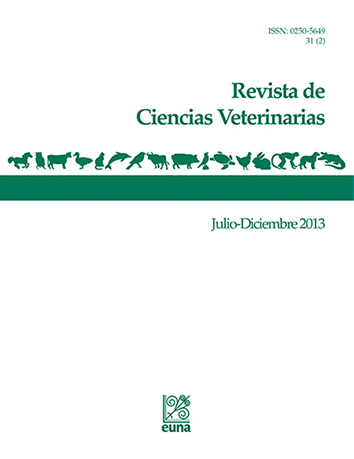In vitro tests to assess the effectiveness of tamarind (Tamarindus indicus) and oxalic acid solutions against cattle tick, Rhipicephalus (Boophilus) microplus
Keywords:
Rhipicephalus microplus, Tamarindus indicus, oxalic acid, tick controlAbstract
An in vitro assay was performed to measure the acaricidal effectiveness of crude-extract of tamarind (Tamarindus indicus) to control the engorged female cattle tick (Rhipicephalus microplus). In addition, a product formulated with oxalic acid (OA) was tested. Parameters measured were percentage of oviposition inhibition and control rate. The best result was obtained with oxalic acid to twice the concentration recommended by the manufacturer for varroa control, followed by the tamarind pulp at 1:3 and 1:4 concentrations. Even though other concentrations of ferment of tamarind crude-extract and half dose of the oxalic acid recommended had lower values, all cases were above 60%, showing a detrimental effect on the tick population. Observations were made of treated ticks using a stereoscope 1-3 hours after the treatment and major injuries were detected. These results support the hypothesis that OA and the crude-extract of tamarind fruits could potentially help to control R. microplus, especially as part of an integral control program against ticks.
References
Alvarez, V. & Herrero, M. 1996. Bibliografía sobre Boophilus microplus (Acari: Ixodidae) y enfermedades transmitidas por esta en Costa Rica. Ciencias Veterinarias. 19 (1-2): 1-10.
Álvarez, V., Bonilla, R. & Chacón, I. 1999. Determinación de la resistencia de la garrapata Boophilus microplus (Acari: Ixodidae) a organofosforados y piretroides en Costa Rica. Rev. Cien. Vet.22:41-60.
Alvarez, V., Bonilla, R. & Chacón, I. 2003. Frecuencia relativa de Boophilus microplus (Acari: Ixodidae) en bovinos Bos taurus y B. indicus en ocho Zonas Ecológicas de Costa Rica. Rev. Biol. Trop. 51(2): 427-434.
Álvarez, V. & Hernández, V. 2010. Diagnóstico de Resistencia a Organofosforados, Piretroides Sintéticos, Amidinas e Ivermectinas en la Garrapata Rhipicephalus microplus en fincas de leche de Costa Rica. Revista FAVE-Ciencias Veterinarias 9(2): 47-56.
Cantú, A. & García, Z. 2013. Estrategias para el control integrado de la garrapata (Boophilus spp.) en la producción de bovinos de carne en pastoreo. Folleto técnico N° MX-0310402-43-03-14-09-36, ISBN 978-607-37-0180-8. INIFAP-CIRNE/P 158s. pp.1-38.
Chungsamarrnyart N. & Jansawan W. 2001. Effect of Tamarindus indicus L. against the Boophilus microplus. Kasetsart J. (Nat. Sci.) 35: 34-39.
Marcangeli, J., García, M., Cano, G., Distéfano, L., Martin, M., Quiroga, A., Raschia, F. & Vega, C. Eficacia del Oxavar® para el Control del Ácaro Varroa destructor (Varroidae) en Colmenas de Apis mellifera (Apidae). Rev. Soc. Entomol. Argent. V.62 n.3-4. Mendoza ago./dic.2003. Versión on line ISSN 1851-7471.
Ministerio de Agricultura y Ganadería (MAG). 1980. Informe Final Proyecto Estudio de Factibilidad para el Control de la Garrapata. San José. Costa Rica. 118 pp.
Nanetti, A. 2007. Uso de ácido oxálico y otros productos de origen natural para el control de varroa, pros y contras. Agro Sur 35(1): 48-50.
Downloads
Published
How to Cite
Issue
Section
License
Licensing of articles
All articles will be published under a license:

Licencia Creative Commons Atribución-NoComercial-SinDerivadas 3.0 Costa Rica.
Access to this journal is free of charge, only the article and the journal must be cited in full.
Intellectual property rights belong to the author. Once the article has been accepted for publication, the author assigns the reproduction rights to the Journal.
Ciencias Veterinarias Journal authorizes the printing of articles and photocopies for personal use. Also, the use for educational purposes is encouraged. Especially: institutions may create links to specific articles found in the journal's server in order to make up course packages, seminars or as instructional material.
The author may place a copy of the final version on his or her server, although it is recommended that a link be maintained to the journal's server where the original article is located.
Intellectual property violations are the responsibility of the author. The company or institution that provides access to the contents, either because it acts only as a transmitter of information (for example, Internet access providers) or because it offers public server services, is not responsible.







